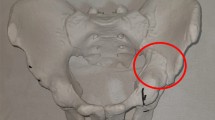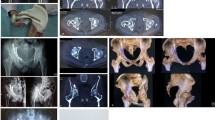Abstract
Purpose
Surgical treatment of acetabular fractures with plate fixation is challenging for orthopaedic surgeons because of variations of the surface curvature and complex fracture patterns of the acetabulum. We present our experience with pre-operative computer-assisted virtual simulation and three-dimensional (3D) printing techniques for the surgical treatment of acetabular fractures, especially in terms of operative time and surgical outcomes.
Methods
Twenty-nine patients with acetabular fractures treated with locking plates were included in this retrospective study (conventional locking plate fixation, n = 17; 3D-printing-assisted precontoured locking plate fixation, n = 12). Fracture types were classified according to the Letournel-Judet classification. Surgical duration, instrumentation time, blood loss, post-operative fracture reduction quality, and complication rates were compared between the two surgical groups.
Results
The 3D-printing group had a significantly shorter total surgical duration and instrumentation time for fractures with posterior wall or posterior column involvement (222.75 ± 48.12 and 35.75 ± 9.21 minutes, respectively; P < 0.05) and significantly shorter instrumentation time and less blood loss for fractures with anterior column involvement (43.40 ± 10.92 minutes and 433.33 ± 317.28 mL, respectively; P < 0.05) than those in the control group. The post-operative radiological results (assessed by consensus) were similar for both groups (good/fair: 14/3 vs. 11/1; P = 0.622). The complication rate was lower in the 3D-printing group than in the conventional group (16.67 vs. 29.41%).
Conclusions
The 3D printing is a reliable method for treating acetabular fractures, and can reduce the surgical duration, instrumentation time, and blood loss.



Similar content being viewed by others
References
Gross BC, Erkal JL, Lockwood SY, Chen C, Spence DM (2014) Evaluation of 3D printing and its potential impact on biotechnology and the chemical sciences. Anal Chem 86:3240–3253
Jammalamadaka U, Tappa K (2018) Recent advances in biomaterials for 3D printing and tissue engineering. J Funct Biomater 9:E22
Cimerman M, Kristan A (2007) Preoperative planning in pelvic and acetabular surgery: the value of advanced computerised planning modules. Injury 38:442–449
Matta JM (1996) Fractures of the acetabulum: accuracy of reduction and clinical results in patients managed operatively within three weeks after the injury. J Bone Joint Surg Am 78:1632–1645
Gao YS, Zhou ZB, Tang MJ, Yu XW, Chen S, Zhang CQ, Sun YQ (2015) Late surgery for acetabular fractures in a Chinese level I trauma Centre: surgical experience and outcomes. Int Orthop 39:1865–1871
Marsh JL, Buckwalter J, Gelberman R, Dirschl D, Olson S, Brown T, Llinias A (2002) Articular fractures: does an anatomic reduction really change the result? J Bone Joint Surg Am 84-A:1259–1271
Ragnarsson B, Mjöberg B (1992) Arthrosis after surgically treated acetabular fractures. Acta Orthop Scand 63:511–514
Brown TD, Johnston RC, Saltzman CL, Marsh JL, Buckwalter JA (2006) Posttraumatic osteoarthritis: a first estimate of incidence, prevalence, and burden of disease. J Orthop Trauma 20:739–744
Munjal S, Leopold SS, Kornreich D, Shott S, Finn HA (2000) CT-generated 3-dimensional models for complex acetabular reconstruction. J Arthroplast 15:644–653
Fuller SM, Butz DR, Vevang CB, Makhlouf MV (2014) Application of 3-dimensional printing in hand surgery for production of a novel bone reduction clamp. J Hand Surg 39:1840–1845
Rankin TM, Giovinco NA, Cucher DJ, Watts G, Hurwitz B, Armstrong DG (2014) 3D printing surgical instruments: are we there yet? J Surg Res 189:193–197
Judet R, Judet J, Letournel E (1964) Fractures of the acetabulum: classification and surgical approaches for open reduction. Preliminary report. J Bone Joint Surg Am 46:1615–1646
Boudissa M, Ruatti S, Kerschbaumer G, Milaire M, Merloz P, Tonetti J (2016) Part 2: outcome of acetabular fractures and associated prognostic factors-a ten-year retrospective study of one hundred and fifty-six operated cases with open reduction and internal fixation. Int Orthop 40:2151–2156
Sebaaly A, Riouallon G, Zaraa M, Upex P, Marteau V, Jouffroy P (2018) Standardized three dimensional computerised tomography scanner reconstructions increase the accuracy of acetabular fracture classification. Int Orthop 42:1957–1965
Wang H, Wang F, Newman S, Lin Y, Chen X, Xu L, Wang Q (2016) Application of an innovative computerized virtual planning system in acetabular fracture surgery: a feasibility study. Injury 47:1698–1701
Martelli N, Serrano C, van den Brink H, Pineau J, Prognon P, Borget I, El Batti S (2016) Advantages and disadvantages of 3-dimensional printing in surgery: a systematic review. Surgery 159:1485–1500
Hu Y, Li H, Qiao G, Liu H, Ji A, Ye F (2011) Computer-assisted virtual surgical procedure for acetabular fractures based on real CT data. Injury 42:1121–1124
Upex P, Jouffroy P, Riouallon G (2017) Application of 3D printing for treating fractures of both columns of the acetabulum: benefit of pre-contouring plates on the mirrored healthy pelvis. Orthop Traumatol Surg Res 103:331–334
Maini L, Sharma A, Jha S, Sharma A, Tiwari A (2018) Three-dimensional printing and patient-specific pre-contoured plate: future of acetabulum fracture fixation? Eur J Trauma Emerg Surg 44:215–224
Guimarães JAM, Martin MP 3rd, da Silva FR, Duarte MEL, Cavalcanti ADS, Machado JAP, Mauffrey C, Rojas D (2018) The obturator oblique and iliac oblique/outlet views predict most accurately the adequate position of an anterior column acetabular screw. Int Orthop. https://doi.org/10.1007/s00264-018-3989-5
Chui KH, Chan CCD, Ip KC, Lee KB, Li W (2018) Three-dimensional navigation-guided percutaneous screw fixation for nondisplaced and displaced pelvi-acetabular fractures in a major trauma Centre. Int Orthop 42:1387–1395
Wu X (2018) A biomechanical comparison of different fixation techniques for fractures of the acetabular posterior wall. Int Orthop 42:673–679
Richter H, Hutson JJ, Zych G (2004) The use of spring plates in the internal fixation of acetabular fractures. J Orthop Trauma 18:179–181
Lee C, Johnson EE (2018) Use of spring plates in fixation of comminuted posterior wall acetabular fractures. J Orthop Trauma 32:S55–S59
Hutt JR, Ortega-Briones A, Daurka JS, Bircher MD, Rickman MS (2015) The ongoing relevance of acetabular fracture classification. Bone Joint J 97-B:1139–1143
Author information
Authors and Affiliations
Corresponding author
Ethics declarations
Conflict of interest
The authors declare that they have no conflicts of interest.
Ethical approval
All procedures performed in studies involving human participants were in accordance with the ethical standards of our Institutional Review Board and with the 1964 Helsinki declaration and its later amendments or comparable ethical standards.
Informed consent
Informed consent was obtained from all individual participants included in the study.
Rights and permissions
About this article
Cite this article
Hsu, CL., Chou, YC., Li, YT. et al. Pre-operative virtual simulation and three-dimensional printing techniques for the surgical management of acetabular fractures. International Orthopaedics (SICOT) 43, 1969–1976 (2019). https://doi.org/10.1007/s00264-018-4111-8
Received:
Accepted:
Published:
Issue Date:
DOI: https://doi.org/10.1007/s00264-018-4111-8




